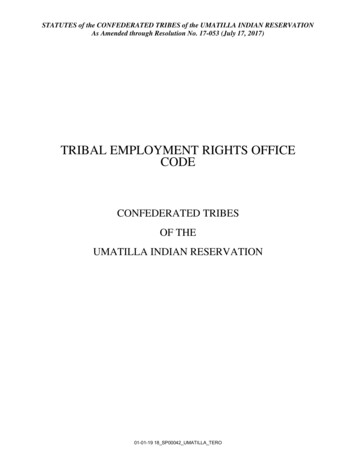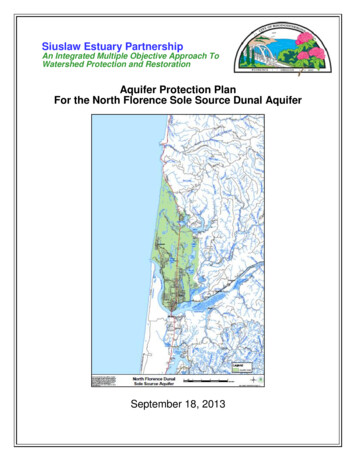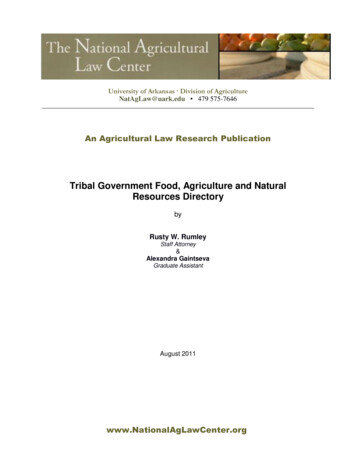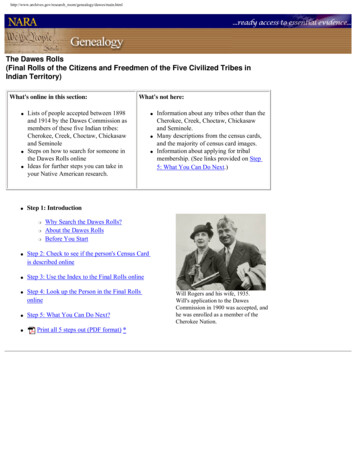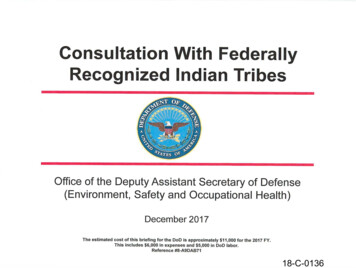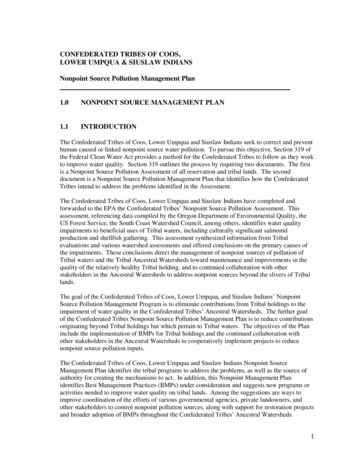
Transcription
CONFEDERATED TRIBES OF COOS,LOWER UMPQUA & SIUSLAW INDIANSNonpoint Source Pollution Management Plan1.0NONPOINT SOURCE MANAGEMENT PLAN1.1INTRODUCTIONThe Confederated Tribes of Coos, Lower Umpqua and Siuslaw Indians seek to correct and preventhuman caused or linked nonpoint source water pollution. To pursue this objective, Section 319 ofthe Federal Clean Water Act provides a method for the Confederated Tribes to follow as they workto improve water quality. Section 319 outlines the process by requiring two documents. The firstis a Nonpoint Source Pollution Assessment of all reservation and tribal lands. The seconddocument is a Nonpoint Source Pollution Management Plan that identifies how the ConfederatedTribes intend to address the problems identified in the Assessment.The Confederated Tribes of Coos, Lower Umpqua and Siuslaw Indians have completed andforwarded to the EPA the Confederated Tribes’ Nonpoint Source Pollution Assessment. Thisassessment, referencing data compiled by the Oregon Department of Environmental Quality, theUS Forest Service, the South Coast Watershed Council, among others, identifies water qualityimpairments to beneficial uses of Tribal waters, including culturally significant salmonidproduction and shellfish gathering. This assessment synthesized information from Tribalevaluations and various watershed assessments and offered conclusions on the primary causes ofthe impairments. These conclusions direct the management of nonpoint sources of pollution ofTribal waters and the Tribal Ancestral Watersheds toward maintenance and improvements in thequality of the relatively healthy Tribal holding, and to continued collaboration with otherstakeholders in the Ancestral Watersheds to address nonpoint sources beyond the slivers of Triballands.The goal of the Confederated Tribes of Coos, Lower Umpqua, and Siuslaw Indians’ NonpointSource Pollution Management Program is to eliminate contributions from Tribal holdings to theimpairment of water quality in the Confederated Tribes’ Ancestral Watersheds. The further goalof the Confederated Tribes Nonpoint Source Pollution Management Plan is to reduce contributionsoriginating beyond Tribal holdings but which pertain to Tribal waters. The objectives of the Planinclude the implementation of BMPs for Tribal holdings and the continued collaboration withother stakeholders in the Ancestral Watersheds to cooperatively implement projects to reducenonpoint source pollution inputs.The Confederated Tribes of Coos, Lower Umpqua and Siuslaw Indians Nonpoint SourceManagement Plan identifies the tribal programs to address the problems, as well as the source ofauthority for creating the mechanisms to act. In addition, this Nonpoint Management Planidentifies Best Management Practices (BMPs) under consideration and suggests new programs oractivities needed to improve water quality on tribal lands. Among the suggestions are ways toimprove coordination of the efforts of various governmental agencies, private landowners, andother stakeholders to control nonpoint pollution sources, along with support for restoration projectsand broader adoption of BMPs throughout the Confederated Tribes’ Ancestral Watersheds.1
Section 319 of the Clean Water Act requires six principal categories of information to be includedin the Tribes’ Nonpoint Source Management Plan. Each of these categories is addressed in thisdocument, and they consist of the following.11.Best Management Practices which will be used to reduce pollution from eachcategory or subcategory of NPS pollution, taking into account the impact of theproposed practice on groundwater quality.2.Nonpoint Source Programs including regulatory and nonregulatory programs forenforcement, technical assistance, financial assistance, education, training,technology transfer, demonstration projects, and monitoring/evaluation to assist inthe implementation of BMPs. The lead and cooperating agencies for carrying outthese programs and their specific responsibilities should be clearly identified.3.A schedule containing annual milestones for the four-year plan which can be usedto gauge the effectiveness of various programs. The schedule shall provide forutilization of BMPs at the earliest practicable date.4.A certification of adequacy of Tribal Ordinances by the Tribal Attorney thatexisting laws and ordinances provide adequate authority to implement theproposed management program. If additional legal authority is needed, a schedulefor seeking such authority shall be adequately expeditious to allowimplementation within the four year Management Program.5.Funding sources which are available to carry the Tribes program in each of thefour fiscal years, in addition to assistance, provided under section 319.6.Federal consistency - The Confederated Tribes of Coos, Lower Umpqua andSiuslaw Indians Management Program should identify federal financial assistanceprograms and federal development projects which will be reviewed by the Statefor their consistency with the proposed NPS Management Plan.2.0319 MANAGEMENT PLAN2.1IntroductionThe Confederated Tribes of Coos, Lower Umpqua and Siuslaw Indians’ 319 Management Planfocuses on mitigating and improving conditions that result in the migration of diffused pollutantsinto the waterways on or near its land. Because most nonpoint source pollutants enter thewaterways via runoff, the management plan must address the affects of precipitation and runoffover the course of the year, rather than on a specific point either in space or time.Unfortunately, nonpoint source pollutants are much more difficult to identify, and their affects areonly felt over time, as there is almost never a single catastrophic event that triggers the problems.The following requirements are taken from Fort Peck Reservation Nonpoint Source Management Plan,”available at the EPA website: http://www.epa.gov/owow/nps/fortpeck/fprnmp.html (.) The entire section is adirect quote from this source.12
Even more confounding is the fact that nonpoint pollutants often interact with one another andmore than one variable can contribute to the problem. Consequently, measures to correct problemsmay only be partially effective. Another difficulty is that the impacts from BMPs take time toevaluate, just as the impact from nonpoint source pollution is the result of long-lived andcumulative build-up over years or decades.Given the difficulties of measuring nonpoint pollution and pinpointing causes, along with the slowbuild-up of the problem, it is not surprising that attempts to control and remediate nonpoint sourcepollution have been slow. Moreover, the Confederated Tribes of Coos, Lower Umpqua, andSiuslaw Indians’ treaty was never ratified, The Tribes had no reservation from 1875 until 1984, theTribes federal recognition was terminated in 1954, restoration in 1984 included no return of land tothe Tribes and recognized the mere 7.4 acres of land held by the Tribes as the “reservation.” Onlyrecently have the Tribes had the resources to develop the Tribes’ Environmental Program and tobegin drafting BMPs.The Tribes have approached the need to address nonpoint source pollution by identifying theprimary categories of nonpoint pollution affecting Tribal waters. These categories are agriculture,forestry, and hydromodificaton. The small and dispersed nature of Tribal holdings result in theconditions of the Tribes’ holdings contributing now or in the future little if any load to impairedwaterbodies, and offering limited opportunity for watershed improvement projects. Theinterconnectedness of a watershed highlight another issue facing any entity wishing to mitigatenonpoint source pollution: in any given watershed, there are several other agencies, organizations,individual landowners, and groups that have control over managing and protecting environmentalresources.With the above challenges identified, the Confederated Tribes of Coos, Lower Umpqua, andSiuslaw Indians Nonpoint Pollution Management Plan stresses prevention, restoration, and a highlevel of coordination and cooperation with other land holders in the Confederated Tribes’Ancestral Watersheds. The development of BMPs discussed in the Assessment is also referencedin this Management Plan. Education and enforcement capacity will contribute to prevention ofcontribution of pollutants by Tribal land users and managers. In addition to BMPs, theConfederated Tribes of Coos, Lower Umpqua, and Siuslaw Indians will establish standards andregulate nonpoint source pollution through its codes and ordinances. Moreover, the Tribesanticipate developing educational programs to encourage voluntary compliance and participationfrom members and other land users.2.2General Management ProgramThe Confederated Tribes of Coos, Lower Umpqua, and Siuslaw Indians’ Environmental Program,through the direction of the Tribal Council, is responsible for the administration of the Tribes’Environmental Ordinances. The ordinances (currently being developed) include a Drinking WaterOrdinance based on the Safe Drinking Water Act, a Water Quality Ordinance which will adoptwater quality standards based on federal core water quality standards, a Construction Storm WaterPollution Prevention Ordinance which will be based on NOAA Fisheries Biological OpinionTerms and Conditions, and various forestry ordinances based on US Forest Service, Bureau ofLand Management, and Oregon Department of Forestry BMPs.The Confederated Tribes of Coos, Lower Umpqua and Siuslaw Indians’ Nonpoint SourceManagement Plan is divided into two parts. The first part is the General Management Program,while the second is the Specific Management Program. As the titles suggest, the General3
Management Program focuses on the overall strategy and philosophy for managing andeliminating nonpoint source pollution. The second part examines specific categories of nonpointsource pollution and addresses the programs designed to ameliorate the harmful affects ofagriculture, hydromodification, forestry, etc. The Specific Management Program identifies BMPs,prioritizes impaired waterways and proposes solutions for the existing problems. In addition, theSpecific Management Program section establishes milestones for the overall program and targetsdates to help measure the Program’s effectiveness. Separate from the Program, the Tribes have aQuality Assurance Project Plan that will guide its water quality monitoring activities. Given thecurrent fiscal environment and availability of Tribal resources, implementation of the majority of319 goals, milestones and targets will depend on the availability of funding.2.2.1 Administration – Administration, including coordination of the General ManagementProgram and the Specific Management Programs, will be carried out by the EnvironmentalProgram of the Tribal Administration. The Environmental Program Coordinator is superviseddirectly by the Tribal Administrator, who reports directly to and receives direction from the TribalCouncil.2.2.2 Assessment - Identifying the nonpoint source pollution problems on the holdings of theConfederated Tribes of Coos, Lower Umpqua, and Siuslaw Indians demands a comprehensiveknowledge of studies, reports, monitoring data, and professional judgment. To date, much of theinformation and data regarding nonpoint source pollution comes from non-tribal sources, includingthe Oregon Department of Environmental Quality, Oregon Department of Fish and Wildlife, theUS Forest Service, and Watershed Associations. The Confederated Tribes have received approvalfrom EPA and will begin directly monitoring Tribal waters under Section 106 of the Clean WaterAct in January 2004.2.2.3 Restoration – Based on the Assessment of Tribal holdings and the Ancestral Watersheds,watersheds restoration projects will be implemented to address contributions of Tribal holdings tononpoint source pollution. Projects will prioritize pollutions which impair water quality to theextent that the affected waterbody is on the Oregon Department of Environmental Quality (ODEQ)303(d) list off water quality limited waterbodies. Projects will generally rely on time-testedmethods of restorations, such as those described in the 1997 Oregon Watershed EnhancementBoard Guide to Aquatic Habitats Restoration; projects may also employ innovative and promisingnew methods of watershed restoration.2.2.4 Monitoring - As the Tribes implement the Section 106 Clean Water Act Tribal WaterQuality Monitoring Program, more data will become available regarding Tribal waters. TheConfederated Tribes have discussed combining monitoring of water quality at the Tribes’ NorthFork Siuslaw estuarine holding with monitoring of the fish community at that site with the OregonDepartment of Fish and Wildlife. Determining BMP effectiveness may prove difficult due to thegenerally small size of Tribal holdings. Pending enactment of legislation which would restore62,86 acres of forest land to the Confederated Tribes, the Tribes will implement the Tribal WaterQuality Monitoring Plan, which integrates the concepts of monitoring for nonpoint sources orpollution such as elevated levels of temperature and turbidity, in the Tribal Forest. These effortsare intended to improve the accuracy of the Confederated Tribes’ assessment, as well as toevaluate the effectiveness of the BMPs to the maximum extent possible.2.2.5 Education - In the long run, no pollution reduction and prevention program can besuccessful without voluntary cooperation and compliance from Tribal Members, leaseholders, andother landowners in the watershed. Therefore, education to explain the benefits of compliance is4
essential for success. Education efforts are accordingly designed to promote understanding of theproblem and BMPs and to promote compliance with all Ordinances. The Environmental Programof the Confederated Tribes of Coos, Lower Umpqua and Siuslaw Indians will develop educationalmaterials designed for members, leaseholders and stakeholders. Outreach activities will includepresentations to stakeholder groups and other affected parties and tours of Tribal holdings todemonstrate BMPs and restoration projects. In addition to Tribal initiatives, the ConfederatedTribes will work cooperatively with other Tribal, federal, state, and local governments, and otherstakeholder groups, and the Tribes will continue to be actively involved in the watershedassociations of the Ancestral Territory.The General Management Program milestones for administration, assessment, restoration,monitoring, and education are summarized in Table 1.Table 1. General Management Program Administrative Milestones.ACTIVITYComplete Tribal review and adoption ofDrinking Water Quality, ConstructionStormwater Pollution Prevention, andBuilding Code Ordinances and BMPsInitiate and implement tribal water qualitymonitoring program as per EPA approvedQAPPOUTPUTBMPs and Ordinances12/31/03Data on temperature, pH, conductivity, dissolvedoxygen, turbidity, and salinity.1/1/04;OngoingRequest 319 Grant from EPAfor implementation ofManagement PlanSuccessful application leading to fundingSubmit revised NPS Assessment andManagement Plan to EPA as necessary2 documents to the EPAPublish articles in Tribal Newsletter on theNonpoint Source Pollution ProgramComplete Tribal review and adoption ofSurface Water Quality Standards andOrdinances, and Road and DevelopmentsStorm Water Pollution Control Ordinancesand BMPsImplement improvements to the stormresistance of roads and other road-relatedturbidity and other nonpoint source controlprojectsImplement riparian vegetation managementprojectsDATE1/21/04Ongoing asnecessaryNewsletter BMPs and Ordinances7/1/04Decreased road-related sediment and other nonpointsource pollution inputsSummers2004 2008Diverse indigenous riparian vegetation with maximumerosion control and shade capabilitySummers2004 20085
Table 1. (Continued)ACTIVITYOUTPUTImplement riparian revegetation projectsDiverse indigenous riparian vegetation with maximumerosion control and shade capabilityImplement instream structure restorationprojectsIncrease sorting and storage of bedload topredisturbance hydrologic functionsConduct tours of nonpoint source pollutionmanagement projectsComplete Tribal review and adoption ofGround Water, and Agricultural WaterQuality Ordinances and BMPsComplete Watershed AssessmentComplete Integrated Management Planincorporating nonpoint source pollutionmanagementComplete Tribal review and adoption ofForestry Water Quality Ordinances andBMPs, Light Development Riparian BufferOrdinance, Human Health OrdinanceComplete brochures on Tribal nonpointsource pollution ordinances and BMPsDATEWinters2004 2008Summers2004 2008Tours to increase awareness and understandingAnnuallyBMPs and Ordinances4/1/05Analysis of watershed processes and conditions7/1/05Integrated management and minimized nonpoint source10/1/05inputsBMPs and Ordinances12/31/05Brochures6/1/0611/1/XXSubmit annual report to EPAAnnual reportSubmit Quarterly Progress Reports4/yearIncorporate priorities intoworkplan for Tribe'sprogram and submit proposals to fundingsources (Tribes, EPA, BIA, OregonWatershed Enhancement Board, etc.)Workplan proposalsOngoingSubmit revised NPS Assessment andManagement Plan to EPA as necessary2 documents to the EPAOngoing asnecessaryQuarterly6
2.2.6Funding NeedsThe Confederated Tribes of Coos, Lower Umpqua and Siuslaw Indians anticipated annual fundingneeds are presented below:Administration/EducationStaff @ 0.25 FTE 25.00/hrBenefits @ 35%Travel & Per DiemTrainingSuppliesPamphlets/ Brochures developmentPrintingWorkbooks and education suppliesDemonstration suppliesSub-Total: 13,200 4,620 1,480 2,000 1,000 2,500 1,600 1,800 2,000 30,200Monitoring ProgramStaff @ 0.5 FTE 15.00/hrBenefits @ 35%Travel & Per DiemTrainingSuppliesLaboratory materials and servicesSub-Total: 15,840 5,545 7,000 2,000 2,000 5,000 37,385Restoration ProgramStaff @ 0.5 FTE 15.00/hrBenefits @ 35%Travel & Per Total:Indirect Costs (Federally negotiated 60% Rate)TOTAL 15,840 5,545 7,000 2,000 3,000 2,000 3,000 10,000 48,385 72,480 188,4507
2.3Specific Management Programs for Nonpoint Pollution CategoriesThe Confederated Tribes of Coos, Lower Umpqua, and Siuslaw Indians are beginning the TribalWater Quality Monitoring Program, have completed the Tribal Nonpoint Source PollutionAssessment, have identified a suite of BMP sources from which to select or tailor BMPs for Tribalholdings, and have secured funding and have approved workplans to adopt BMPs and Ordinancesintended to prevent nonpoint source pollution from originating from Tribal holdings. Themanagement decisions the Tribes have and will make are based on the best science available,professional judgment, and site-specific considerations, and cultural priorities. Among theconsiderations the Tribes take into account are the following variables.1. Severity of pollution problem and extent to which tribal and other beneficial uses areimpaired;22. Potential for the Tribes to effectively address the pollution problem, given technical,financial, and geographic/hydrologic constraints (i.e. optimizing economic benefits);3. Potential for actions to be a component of a larger reach, watershed, Gene ConservationGroup, or Evolutionarily Significant Unit scale effort.4. Cultural considerations addressed by the action.As the Confederated Tribes develop and implement projects, the Tribes continually review andevaluate the programs and activities. In addition, the Confederated Tribes may participate inprojects when the Tribes are not the sole or primary sponsor: the Tribes have teamed withwatershed associations, soil and water conservation districts, or other government agencies to worktoward common goals. Regardless of the specific arrangement, the goals shall remain thesystematic enforcement of Ordinances on Tribal holdings and application of BMPs to preventnonpoint source pollution and to restore the processes which maintain water quality andfunctioning aquatic habitats. This Nonpoint Source Management Plan and the below tables ofpertinent nonpoint source pollution category activities and outcomes will serve as the Tribes’Action Plan for achieving the goal of restoring water quality in the Ancestral Watersheds.2.3.1Agricultural MilestonesAgricultural practices are believed to be a significant if not the primary contributor to theimpairment of Tribal holdings in the Coos Estuary. Fecal coliform bacteria, believed to mostlyoriginate from cattle ranches and dairies, contribute to the impairment of the Coos Estuary andmay contribute directly or indirectly to impairment of the Siuslaw Estuary. Elevated turbidity andtemperature impairs the water quality of the North Fork Siuslaw River/Estuary and many otherfish-bearing streams of the ancestral watersheds. Depressed dissolved oxygen concentrationimpairs the water quality of the Sixes River, located in a small coastal watershed with a largeamount of nutrient input from livestock instream watering. The Confederated Tribes of Coos,Lower Umpqua, and Siuslaw Indians do not currently nor will in the foreseeable future hold landin agricultural use. The Confederated Tribes will none-the-less develop the regulatory capacity toprevent non-point source pollution from agricultural lands through the enactment of anAgricultural Ordinance which will include components to address nonpoint source pollution.Utilization of agricultural BMPs for nonpoint source pollution control on Confederated Tribes of2Ibid.8
Coos, Lower Umpqua and Siuslaw Indians land is voluntary, but compliance with Water QualityStandards is not. These BMPs and Ordinances will rely heavily on Natural Resource ConservationService guidance, as well as local Agricultural Water Quality Management Plans. TheConfederated Tribes will use the Tribes moral authority, political influence, and available financialresources to assist agricultural landowners in the Ancestral Watersheds to eliminate nonpointsources of agricultural pollution. The Agricultural Management Program milestones aresummarized in Table 2.Table 2. Agricultural Management Program Milestones.ACTIVITYOUTPUTDATEInitiate and implement tribal water qualitymonitoring program as per EPA approvedQAPPData on temperature, pH,conductivity, dissolved oxygen,turbidity, and salinity.1/1/04; OngoingPublish articles in Tribal Newsletter on theNonpoint Source Pollution ProgramNewsletter Articles8/04 temperature 1/05 turbidity2/06ordinancesComplete Tribal review and adoption ofSurface Water Quality Standards andOrdinancesBMPs and Ordinances7/1/04Implement riparian vegetation managementprojectsImplement riparian revegetation projectsImplement instream structure restorationprojectsComplete Tribal review and adoption ofGround Water, and Agricultural WaterQuality Ordinances and BMPsComplete Integrated Management Planincorporating nonpoint source pollutionmanagementComplete brochures on Tribal nonpointsource pollution ordinances and BMPs2.3.2Diverse indigenous riparianvegetation with maximum erosioncontrol and shade capabilityDiverse indigenous riparianvegetation with maximum erosioncontrol and shade capabilityIncrease sorting and storage ofbedload to predisturbancehydrologic functionsSummers 2004 - 2008Winters 2004 - 2008Summers 2004 - 2008BMPs and Ordinances4/1/05Integrated management andminimized nonpoint source inputs10/1/05Brochures6/1/06ForestryForestry activities have a profound effect on the water quality of Tribal waters. While forestry isnot the sole contributor to the impairments, elevated turbidity and temperature levels impair thewater quality of the Tribal holding at the site of the Ancestral Siuslaw Village on the North ForkSiuslaw Estuary. Elevated temperature impairs the water quality of the Sixes River, and when Agrade data on turbidity is collected, evaluation indicates that the Sixes River will likely be listedfor sediment as well. Much of the Tribal land holdings are forested, however, the Tribes do notactively manage forested Tribal holdings due to cultural, historical, environmental, or silvicultural9
reasons, depending on the tract. As with agricultural practices, the forestry practices that doimpact tribal water quality tend to be upstream (or tidally downstream) operations, largely onprivate lands.While the Confederated Tribes of Coos, Lower Umpqua, and Siuslaw Indians currently do notengage in commercial forestry, legislation has been introduced in the United States Senate torestore 62,865 acres of the Siuslaw National Forest to the Confederated Tribes of Coos, LowerUmpqua, and Siuslaw Indians. The opportunity and responsibility to manage the Tribal Forest willdominate the Confederated Tribes’ Nonpoint Source Pollution Management Program. The TribalForest will be managed according to the provision of the National Indian Forest ResourcesManagement Act, as well as the enabling legislation which currently and in all probability willcontinue to direct the management of the Tribal Forest to achieve the management and restorationgoals for nearby and adjacent Federal land, currently managed under the Northwest Forest Plan.Under the legislation, the Bureau of Indian Affairs, with the Assistance of the US Forest Service,will develop a management plan for the Tribal Forest. Within this Tribal Forest Management Planwill be incorporated the goals and objectives of the Confederated Tribes Nonpoint SourcePollution Management Plan, including Tribal BMPs and Ordinances. While the language of thelegislation will largely determine these Tribal BMPs and Ordinances, the Confederated Tribes willconsider all sources of forestry BMPs which can contribute to the minimization of nonpoint sourcepollution related to forestry activities, including the Northwest Forest Plan Record of Decision,including the Aquatic Conservation Strategies, the (in progress) Management and HabitatConservation Plans for the Northwest State Forests and the Elliott State Forest, the OregonDepartment of Forestry 2002 Forest Roads Manual, and references available from the US EPA.With or without the restoration of forest land to the Confederated Tribes of Coos, Lower Umpqua,and Siuslaw Indians, the Confederated Tribes will implement forest watershed restoration projectsin Tribal holdings, and the Confederated Tribes will use the Tribes’ moral authority, politicalinfluence, and available financial resources to assist forest landowners in the Ancestral Watershedsto eliminate nonpoint sources of silvicultural pollution. The Forest Management Programmilestones are summarized in Table 3.Table 3. Forest Management Program Milestones.ACTIVITYInitiate and implement tribal water qualitymonitoring program as per EPA approvedQAPPOUTPUTDATEData on temperature, pH, conductivity, dissolvedoxygen, turbidity, and salinity.1/1/04;OngoingPublish articles in Tribal Newsletter on theNonpoint Source Pollution ProgramNewsletter Complete Tribal review and adoption ofSurface Water Quality Standards andOrdinancesBMPs and Ordinances7/1/0410
Table 3. (Continued)Implement improvements to the stormresistance of roads and other road-relatedturbidity and other nonpoint source controlprojectsDecreased road-related sediment and other nonpointsource pollution inputsImplement riparian vegetation managementprojectsDiverse indigenous riparian vegetation with maximumerosion control and shade capabilityImplement riparian revegetation projectsDiverse indigenous riparian vegetation with maximumerosion control and shade capabilityConduct tours of nonpoint source pollutionmanagement projectsTours to increase awareness and understandingAnnuallyImplement instream structure restorationprojectsIncrease sorting and storage of bedload topredisturbance hydrologic functionsSummers2004 2008Anticipated enactment of Forest LandRestoration Proposal legislationRestoration of 62,865 acres of the Siuslaw NationalForest to the Confederated Tribes of Coos, LowerUmpqua, and Siuslaw Indians2004Complete Integrated Management Planincorporating nonpoint source pollutionmanagementComplete Tribal review and adoption ofForestry Water Quality Ordinances andBMPsComplete brochures on Tribal nonpointsource pollution ordinances and BMPsCompletion, with the assistance of the USForest Service, of the Tribal ForestResource Management Plan20 % of annual Tribal Forest revenue (est. 200k) dedicated to watershed restoration2.3.3Summers2004 2008Summers2004 2008Winters2004 2008Integrated management and minimized nonpoint source10/1/05inputsBMPs and Ordinances12/31/05Brochures6/1/06Resource Management Plan2006Massive Improvements to the Storm Resistance of2005 Road Systems (ISR); Riparian conifer re-establishment;2020Instream structure restoration and bedload recoveryHydromodificationHydromodification is a process that can relate to several other categories of nonpoint sourcepollution. For example, any activity which increases erosion can result in hydromodification.Consequently, the best management practices for hydrologic and habitat modification often relatedirectly to other categories of nonpoint source pollution. As discussed in the Confederated Tribesof Coos, Lower Umpqua, and Siuslaw Indians’ Nonpoint Source Pollution Assessment,hydromodification in the combined form of large pulses of sediment, riparian vegetation removal,and instream structure removal, indirectly related to forestry and agricultural practices, has resultedin water quality (elevated temperature and sediment) impairments due to losses of streambankstability and shade, and due to shallower base flows, particularly in stream channels downcut tobedrock. While many activities that result in hydromodification are regulated and permitted underSection 404 of the Clean Water Act and other regulatory pathways, many other activities are notjurisdictional to this regulation, thus BMPs and voluntary cooperation in restoration p
Siuslaw Indians Management Program should identify federal financial assistance programs and federal development projects which will be reviewed by the State for their consistency with the proposed NPS Management Plan. 2.0 319 MANAGEMENT PLAN 2.1 Introduction The Confederated Tribes of Coos, Lower Umpqua and Siuslaw Indians'319 Management Plan
